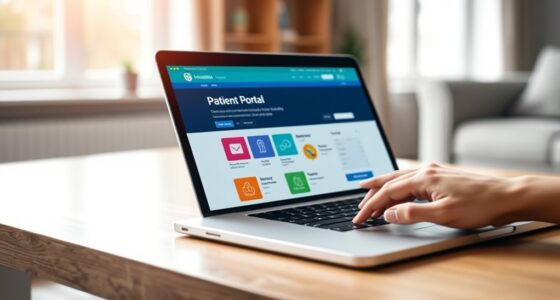To secure medical data, you should use strong encryption techniques to convert sensitive information into unreadable formats that only authorized users can access with proper keys. Combine this with strict access controls, such as role-based permissions and multi-factor authentication, to prevent unauthorized entry. Regularly update security protocols and conduct audits to identify vulnerabilities. If you want to learn how these measures work together to create a robust security system, keep exploring further.
Key Takeaways
- Encryption transforms medical data into unreadable formats, ensuring data confidentiality during storage and transmission.
- Access controls limit data visibility to authorized personnel, reducing risk of unauthorized disclosure.
- Role-based permissions align user privileges with responsibilities, enhancing data security.
- Multi-factor authentication adds extra verification layers for accessing sensitive medical information.
- Combining blockchain verification with encryption and access controls creates a comprehensive, resilient security framework.

In today’s digital healthcare landscape, protecting medical data is more critical than ever. With sensitive information flowing through various systems and platforms, you need robust measures to safeguard patient privacy and maintain trust. One effective approach is leveraging blockchain verification, which provides an unchangeable record of data transactions. When you implement blockchain verification, you guarantee that each access or modification is recorded securely, making it nearly impossible for unauthorized parties to tamper with the data. This technology adds an extra layer of transparency and accountability, allowing you to track who accessed or changed information, when they did it, and what exactly was altered. It’s a powerful tool in preventing data breaches and ensuring the integrity of your medical records.
Alongside blockchain, cloud storage security plays an essential role in defending medical data. Cloud solutions offer scalability and easy access, but they also present unique challenges in protecting sensitive information. You must choose cloud providers with strong security protocols, including end-to-end encryption, multi-factor authentication, and regular security audits. Encrypting data both during transmission and while stored in the cloud protects it from interception or unauthorized access. When you control access through strict permissions and monitor activity logs diligently, you greatly reduce the risk of internal or external breaches. Cloud storage security isn’t just about technology; it’s about establishing an all-encompassing security framework that covers policies, procedures, and staff training to prevent vulnerabilities. Incorporating advanced encryption techniques can further strengthen your defenses against emerging threats.
Effective cloud security combines encryption, strict access controls, audits, and comprehensive policies to protect sensitive medical data.
Encryption acts as the foundation of data protection in this environment. When you encrypt medical data, you convert it into an unreadable format that only authorized parties can decrypt. This means even if someone manages to access your storage, they won’t be able to interpret the information without the decryption keys. Combining encryption with access controls ensures that only those with proper permissions can view or modify sensitive records. You can set up role-based access, where each user has specific privileges aligned with their responsibilities, minimizing the risk of accidental or malicious data exposure. Regularly updating encryption protocols and access policies keeps your defenses strong against evolving threats.
Ultimately, securing medical data requires a multi-layered approach. Blockchain verification enhances data integrity and traceability, while cloud storage security defends against breaches and unauthorized access. When you integrate these technologies with strong encryption and precise access controls, you create a resilient environment where patient information remains confidential and protected. Staying proactive, keeping systems updated, and continuously monitoring for vulnerabilities will help you maintain the highest standards of data security in the complex landscape of digital healthcare.
Frequently Asked Questions
How Often Should Encryption Protocols Be Updated?
You should update encryption protocols regularly, ideally every 6 to 12 months, to keep up with evolving threats. Maintain proper encryption key management to guarantee keys remain secure, and implement protocol version updates promptly when new vulnerabilities are discovered. Regular updates help prevent breaches, protect patient data, and ensure compliance with industry standards. Staying proactive with these updates minimizes risks and maintains the integrity of your medical data security.
What Are the Best Practices for User Access Management?
Did you know that 84% of data breaches happen due to poor access controls? To manage user access effectively, implement strong user authentication methods like multi-factor authentication. Use role-based access to ensure users only see data necessary for their job. Regularly review and update access permissions, especially when employees change roles or leave. This proactive approach minimizes risks and keeps sensitive medical data protected.
How Is Data Breach Detection Integrated Into Security Systems?
You integrate data breach detection into security systems through intrusion detection systems that monitor network activity for suspicious behavior. When a breach is detected, you activate breach response plans to contain and mitigate damage quickly. These systems continuously analyze logs and traffic, providing real-time alerts so you can respond promptly. Regular updates and testing guarantee your detection methods stay effective, helping you safeguard sensitive medical data proactively.
What Legal Requirements Govern Medical Data Encryption?
Oh, sure, just ignore those pesky legal requirements like HIPAA or GDPR when encrypting medical data! You must get patient consent before encrypting sensitive info, and guarantee data anonymization is in place to protect identities. These laws mandate robust encryption standards, secure access controls, and regular audits. Ignoring them risks hefty fines and loss of trust, so follow the rules—your patients’ privacy depends on it.
How Do Medical Institutions Handle Data Recovery After Breaches?
When a data breach occurs, you should follow a structured data breach response plan that includes quick containment and assessment. Recovery planning involves restoring systems from secure backups, verifying data integrity, and implementing additional security measures. You actively coordinate with IT and legal teams to minimize damage, notify affected parties as required, and prevent future incidents, ensuring your institution maintains trust and complies with legal standards.
Conclusion
By now, you see that encryption and access controls aren’t just tech jargon—they’re essential for protecting medical data. Some believe that advanced security measures alone can completely prevent breaches, but history shows that no system is foolproof. The truth is, combining strong encryption with strict access controls creates a robust defense. Stay vigilant and proactive, because in healthcare, safeguarding sensitive info isn’t just a theory—it’s a necessity you can’t afford to ignore.








